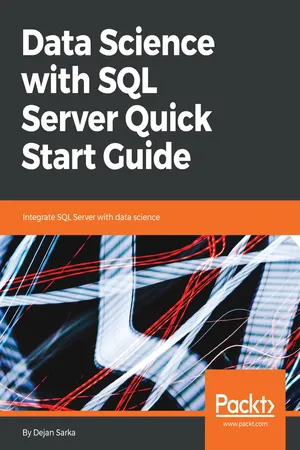
Data Science with SQL Server Quick Start Guide
Integrate SQL Server with data science
- 206 pages
- English
- ePUB (mobile friendly)
- Available on iOS & Android
About this book
Get unique insights from your data by combining the power of SQL Server, R and Python
Key Features
- Use the features of SQL Server 2017 to implement the data science project life cycle
- Leverage the power of R and Python to design and develop efficient data models
- find unique insights from your data with powerful techniques for data preprocessing and analysis
Book Description
SQL Server only started to fully support data science with its two most recent editions. If you are a professional from both worlds, SQL Server and data science, and interested in using SQL Server and Machine Learning (ML) Services for your projects, then this is the ideal book for you.
This book is the ideal introduction to data science with Microsoft SQL Server and In-Database ML Services. It covers all stages of a data science project, from businessand data understanding, through data overview, data preparation, modeling and using algorithms, model evaluation, and deployment.
You will learn to use the engines and languages that come with SQL Server, including ML Services with R and Python languages and Transact-SQL. You will also learn how to choose which algorithm to use for which task, and learn the working of each algorithm.
What you will learn
- Use the popular programming languages, T-SQL, R, and Python, for data science
- Understand your data with queries and introductory statistics
- Create and enhance the datasets for ML
- Visualize and analyze data using basic and advanced graphs
- Explore ML using unsupervised and supervised models
- Deploy models in SQL Server and perform predictions
Who this book is for
SQL Server professionals who want to start with data science, and data scientists who would like to start using SQL Server in their projects will find this book to be useful. Prior exposure to SQL Server will be helpful.
Frequently asked questions
- Essential is ideal for learners and professionals who enjoy exploring a wide range of subjects. Access the Essential Library with 800,000+ trusted titles and best-sellers across business, personal growth, and the humanities. Includes unlimited reading time and Standard Read Aloud voice.
- Complete: Perfect for advanced learners and researchers needing full, unrestricted access. Unlock 1.4M+ books across hundreds of subjects, including academic and specialized titles. The Complete Plan also includes advanced features like Premium Read Aloud and Research Assistant.
Please note we cannot support devices running on iOS 13 and Android 7 or earlier. Learn more about using the app.
Information
Unsupervised Machine Learning
- Installing ML Services (In-Database) packages
- Performing market-basket analysis
- Finding clusters of similar cases
- Dimensionality-reduction with principal-component analysis
- Extracting underlying factors from variables
Installing ML services (In-Database) packages

USE AdventureWorksDW2017;
EXECUTE sys.sp_execute_external_script
@language=N'R',
@script =
N'str(OutputDataSet);
instpack <- installed.packages();
NameOnly <- instpack[,1];
OutputDataSet <- as.data.frame(NameOnly);'
WITH RESULT SETS (
( PackageName nvarchar(20) )
);
GO
Table of contents
- Title Page
- Copyright and Credits
- Packt Upsell
- Contributors
- Preface
- Writing Queries with T-SQL
- Introducing R
- Getting Familiar with Python
- Data Overview
- Data Preparation
- Intermediate Statistics and Graphs
- Unsupervised Machine Learning
- Supervised Machine Learning
- Other Books You May Enjoy